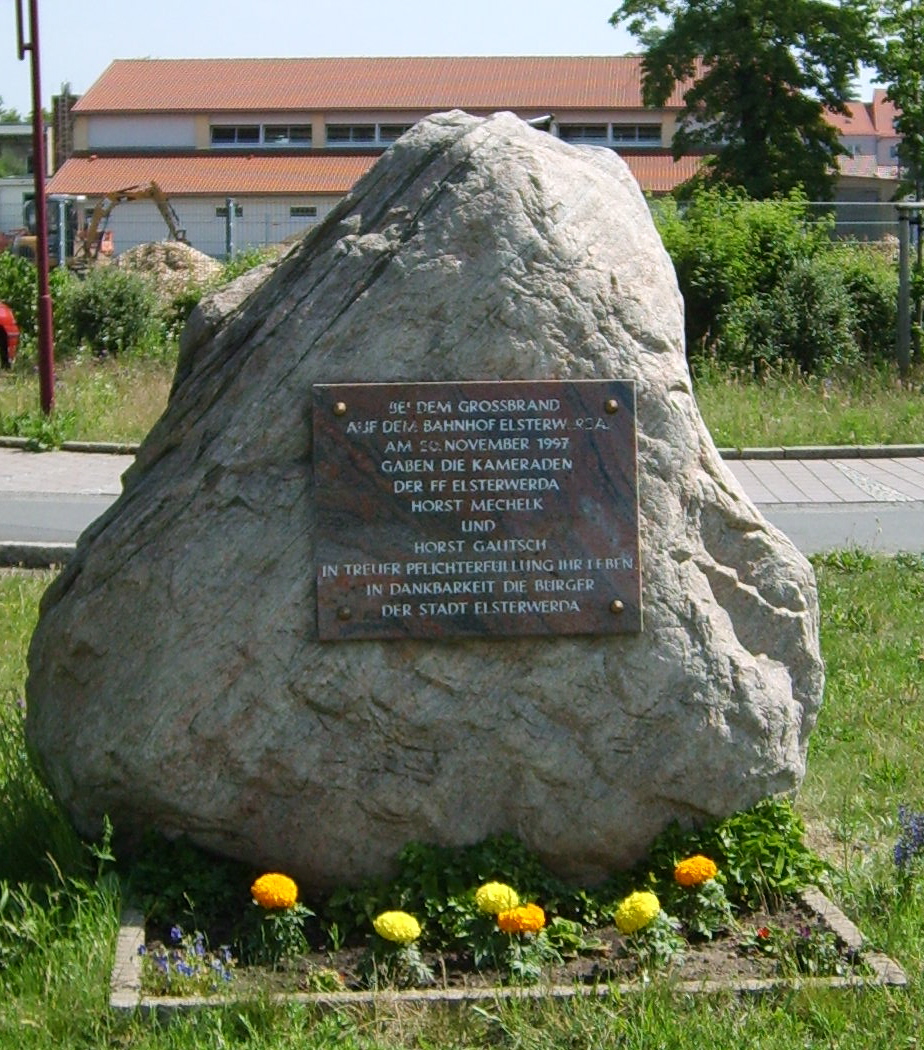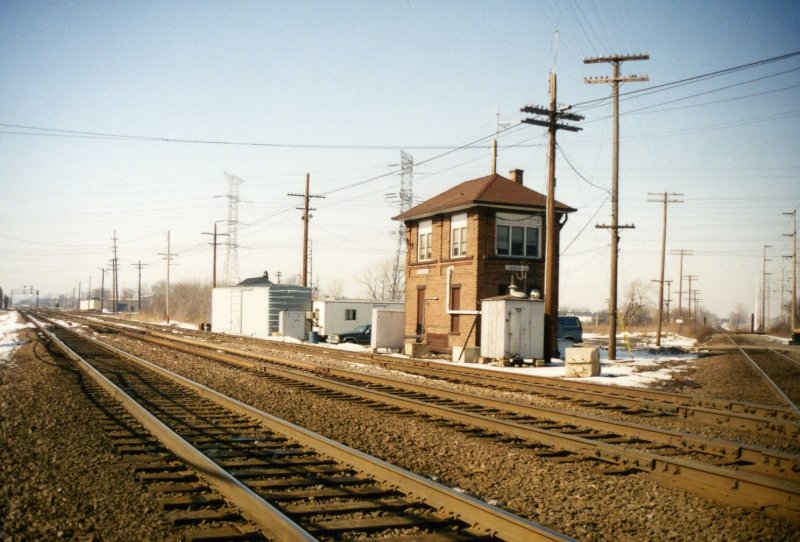|
Elsterwerda Station
Elsterwerda station is in the town of Elsterwerda in the German state of Brandenburg. It lies on the Berlin–Dresden railway. The station is known for a train crash in 1997, when a freight train with 22 petrol tankers derailed and exploded on the station premises. Infrastructure The station has had three platform edges since its reconstruction in the 1990s: *the main platform next to the station building, which is 300 m long and 55 cm high, *an island platform, which is 300 m long and 38 cm high. An underpass that is reached by stairs connects the island platform with the main platform. History Friedrich Jage, a master mason and later an honorary citizen of Elsterwerda, built the then three-storey station building according to the specifications of the Berlin-Dresden Railway Company (''Berlin-Dresdener Eisenbahn-Gesellschaft'') in "American"-style timber construction. The station was opened with the Berlin-Dresden railway on 17 June 1875 without a public opening ... [...More Info...] [...Related Items...] OR: [Wikipedia] [Google] [Baidu] |
Elsterwerda
Elsterwerda (; Lower Sorbian: ''Wikow'') is a town in the Elbe-Elster district, in southwestern Brandenburg, Germany. It is situated on the Black Elster river, 48 km northwest of Dresden, and 11 km southeast of Bad Liebenwerda. History From 1952 to 1990, Elsterwerda was part of the Bezirk Cottbus of East Germany. Demography File:Bevölkerungsentwicklung Elsterwerda.pdf, Development of Population since 1875 within the Current Boundaries (Blue Line: Population; Dotted Line: Comparison to Population Development of Brandenburg state; Grey Background: Time of Nazi rule; Red Background: Time of Communist rule) File:Bevölkerungsprognosen Elsterwerda.pdf, Recent Population Development and Projections (Population Development before Census 2011 (blue line); Recent Population Development according to the Census in Germany in 2011 (blue bordered line); Official projections for 2005-2030 (yellow line); for 2020-2030 (green line); for 2017-2030 (scarlet line) Gallery Posts� ... [...More Info...] [...Related Items...] OR: [Wikipedia] [Google] [Baidu] |
Berlin
Berlin is Capital of Germany, the capital and largest city of Germany, both by area and List of cities in Germany by population, by population. Its more than 3.85 million inhabitants make it the European Union's List of cities in the European Union by population within city limits, most populous city, as measured by population within city limits having gained this status after the United Kingdom's, and thus London's, Brexit, departure from the European Union. Simultaneously, the city is one of the states of Germany, and is the List of German states by area, third smallest state in the country in terms of area. Berlin is surrounded by the state of Brandenburg, and Brandenburg's capital Potsdam is nearby. The urban area of Berlin has a population of over 4.5 million and is therefore the most populous urban area in Germany. The Berlin/Brandenburg Metropolitan Region, Berlin-Brandenburg capital region has around 6.2 million inhabitants and is Germany's second-largest metropolitan reg ... [...More Info...] [...Related Items...] OR: [Wikipedia] [Google] [Baidu] |
Bahnhof Berlin-Spandau
Berlin-Spandau station is a Deutsche Bahn station in the Berlin district of Spandau on the south-western edge of the old town of Spandau. The railway junction station is one of the 80 stations classified by Deutsche Bahn as a category 2 station. It has the longest train shed (440 metres) in Germany. The high-traffic station with six platform tracks is a transfer point between long-distance passenger services— Intercity-Express (ICE), Intercity (IC) and EuroCity (EC)—and regional services ( S-Bahn, Regionalbahn and Regional-Express). It also provides connections to the inner city by the public transport services operated by the Berliner Verkehrsbetriebe: buses and U-Bahn line U7 at the adjacent Rathaus Spandau station. The Berlin–Hamburg railway from the northwest and the Berlin–Lehrte railway from the west join together west of the station and the combined lines, after passing through the station, runs over a bridge over the Havel and continues to the east an ... [...More Info...] [...Related Items...] OR: [Wikipedia] [Google] [Baidu] |
Rostock Hauptbahnhof
Rostock Hauptbahnhof, also Rostock Central Station (from 1896 until the turn of the 20th century called ''Rostock Central-Bahnhof''), is the main railway station in the German city of Rostock. It is situated well to the south of the city centre, to which it is linked by tram. The station was opened in 1886 by the ''Deutsch-Nordischer Lloyd'', operating a combined railway/ferry line to Nykøbing Falster in Denmark. The station was expanded in 1913 and 1922, but was heavily damaged in World War II. The importance of the traditional route to Hamburg and Copenhagen diminished after the post-World War II division of Germany, with long-distance services instead focusing on cities within the German Democratic Republic. Electrification reached the station in 1985. After German reunification, the station was extensively modernised. History Today's station was opened in 1886 by the ''Deutsch-Nordische-Lloyd'' (German-Nordic-Lloyd) Railway Company as the ''Lloyd-Bahnhof'' (“station ... [...More Info...] [...Related Items...] OR: [Wikipedia] [Google] [Baidu] |
Neustrelitz Hauptbahnhof
Neustrelitz Hauptbahnhof (german: Neustrelitz main station) is a railway station in the city of Neustrelitz, Mecklenburg-Vorpommern, Germany. The station lies on the Stralsund-Neubrandenburg railway, Neustrelitz–Warnemünde railway and . The train services are operated by Deutsche Bahn, DB Regio Nordost, and Hanseatische Eisenbahn. Next to the main station, a separate station was built for the formerly private railway from the Prussian border at Buschhof to Strasburg, now called ''Neustrelitz Süd'' (south). Its entrance building and several outbuildings to the station have heritage protection. Location and name The station is located east of central Neustrelitz at kilometer 98.5 of the Berlin Northern Railway. The line from Berlin reaches Neustrelitz from the south and, north of the station, it turns to the east. The Neustrelitz–Warnemünde railway (''Lloydbahn'', Lloyd Railway) begins at the station and runs to the northwest. Neustrelitz Süd station on the Witte ... [...More Info...] [...Related Items...] OR: [Wikipedia] [Google] [Baidu] |
Berlin Hauptbahnhof
Berlin Hauptbahnhof () (English: Berlin Central Station) is the main railway station in Berlin, Germany. It came into full operation two days after a ceremonial opening on 26 May 2006. It is located on the site of the historic Lehrter Bahnhof, and on the Berlin S-Bahn suburban railway. The station is operated by DB Station&Service, a subsidiary of Deutsche Bahn AG, and is classified as a Category 1 station, one of 21 in Germany and four in Berlin, the others being Berlin Gesundbrunnen, Berlin Südkreuz and Berlin Ostbahnhof. ''Lehrter Bahnhof'' (Lehrte Station) opened in 1871 as the terminus of the railway linking Berlin with Lehrte, near Hanover, which later became Germany's most important east–west main line. In 1882, with the completion of the Stadtbahn (City Railway, Berlin's four-track central elevated railway line, which carries both local and main line services), just north of the station, a smaller interchange station called Lehrter Stadtbahnhof was opened to pro ... [...More Info...] [...Related Items...] OR: [Wikipedia] [Google] [Baidu] |
Dresden Hauptbahnhof
Dresden Hauptbahnhof ("main station", abbreviated Dresden Hbf) is the largest passenger station in the Saxon capital of Dresden. In 1898, it replaced the ''Böhmischen Bahnhof'' ("Bohemian station") of the former Saxon-Bohemian State Railway (''Sächsisch-Böhmische Staatseisenbahn''), and was designed with its formal layout as the central station of the city. The combination of a station building on an island between the tracks and a terminal station on two different levels is unique. The building is notable for its train-sheds, which are roofed with Teflon-coated glass fibre membranes. This translucent roof design, installed during the comprehensive restoration of the station at the beginning of the 21st century, allows more daylight to reach the concourses than was previously possible. The station is connected by the Dresden railway node to the tracks of the Děčín–Dresden-Neustadt railway and the Dresden–Werdau railway (Saxon-Franconian trunk line), allowing traffi ... [...More Info...] [...Related Items...] OR: [Wikipedia] [Google] [Baidu] |
Chemnitz Hauptbahnhof
Chemnitz Hauptbahnhof is the main railway station in Chemnitz in Germany. Station building The station has a combination of terminating and through platforms. Platform tracks 5 to 9 terminate and tracks 1 to 4 and 10 to 14 continue to the west of Chemnitz towards Zwickau, Nuremberg and Göttingen. Tracks 11 to 14 are reached by a passenger subway. The subway also passes under tracks 15 and 16, which have no platforms. The platforms are also accessible by lift. From 15 December 2002 until 17 February 2013, "Chemnitz model" tram-trains of the City-Bahn Chemnitz operated from platform 102 (a tram track) in the station forecourt. The tram-train services now use platforms 1 to 4. Bus lines 23 (Heinersdorf–Neefepark) and 32 (Dresdner Str–Rabenstein, Tierpark), tram lines 2 (Hauptbahnhof–Bernsdorf) and 6 (Hauptbahnhof–Altchemnitz) and the City-Bahn line to Stollberg connect the Hauptbahnhof to the central tram station in central Chemnitz. Near the Hauptbahnhof is the bus st ... [...More Info...] [...Related Items...] OR: [Wikipedia] [Google] [Baidu] |
Electronic Interlocking
In railway signalling, an interlocking is an arrangement of signal apparatus that prevents conflicting movements through an arrangement of tracks such as junctions or crossings. The signalling appliances and tracks are sometimes collectively referred to as an ''interlocking plant''. An interlocking is designed so that it is impossible to display a signal to proceed unless the route to be used is proven safe. Interlocking is a safety measure designed to prevent signals and points/switches from being changed in an improper sequence. For example interlocking would prevent a signal from being changed to indicate a diverging route, unless the corresponding points/switches had been changed first. In North America, the official railroad definition of interlocking is: "''An arrangement of signals and signal appliances so interconnected that their movements must succeed each other in proper sequence''". Configuration and use A minimal interlocking consists of signals, but usually ... [...More Info...] [...Related Items...] OR: [Wikipedia] [Google] [Baidu] |
Stuttgart
Stuttgart (; Swabian: ; ) is the capital and largest city of the German state of Baden-Württemberg. It is located on the Neckar river in a fertile valley known as the ''Stuttgarter Kessel'' (Stuttgart Cauldron) and lies an hour from the Swabian Jura and the Black Forest. Stuttgart has a population of 635,911, making it the sixth largest city in Germany. 2.8 million people live in the city's administrative region and 5.3 million people in its metropolitan area, making it the fourth largest metropolitan area in Germany. The city and metropolitan area are consistently ranked among the top 20 European metropolitan areas by GDP; Mercer listed Stuttgart as 21st on its 2015 list of cities by quality of living; innovation agency 2thinknow ranked the city 24th globally out of 442 cities in its Innovation Cities Index; and the Globalization and World Cities Research Network ranked the city as a Beta-status global city in their 2020 survey. Stuttgart was one of the host cit ... [...More Info...] [...Related Items...] OR: [Wikipedia] [Google] [Baidu] |
Der Tagesspiegel
''Der Tagesspiegel'' (meaning ''The Daily Mirror'') is a German daily newspaper. It has regional correspondent offices in Washington D.C. and Potsdam. It is the only major newspaper in the capital to have increased its circulation, now 148,000, since reunification. ''Der Tagesspiegel'' is a liberal newspaper that is classified as centrist media in the context of German politics. History and profile Founded on 27 September 1945 by Erik Reger, Walther Karsch and Edwin Redslob, ''Der Tagesspiegel'' main office is based in Berlin at Askanischer Platz in the locality of Kreuzberg, about from Potsdamer Platz and the former location of the Berlin Wall. For more than 45 years, ''Der Tagesspiegel'' was owned by an independent trust. In 1993, in response to an increasingly competitive publishing environment, and to attract investments required for technical modernisation, such as commission of a new printing plant, and improved distribution, it was bought by the Georg von Holtzb ... [...More Info...] [...Related Items...] OR: [Wikipedia] [Google] [Baidu] |










